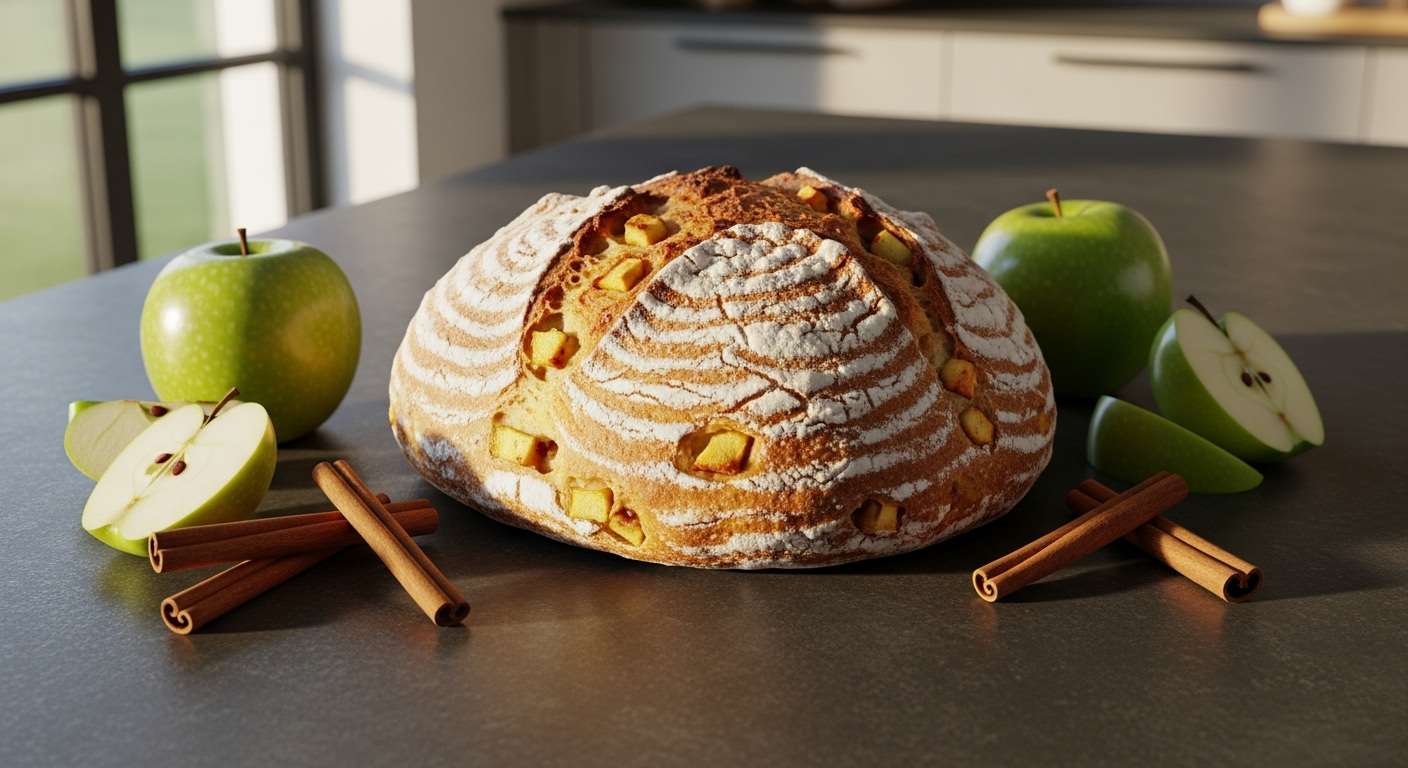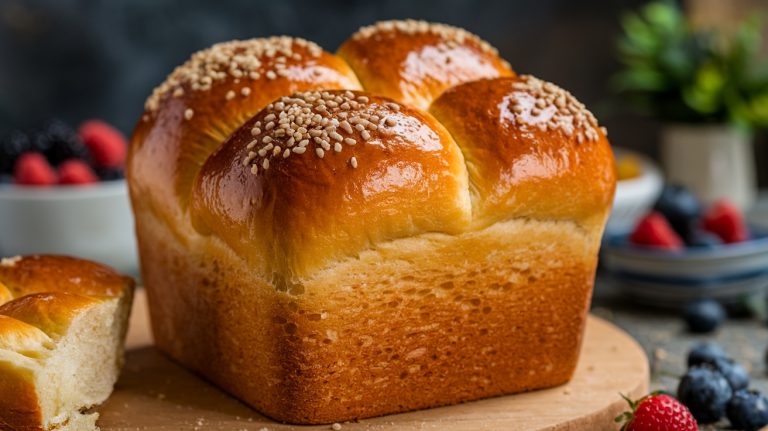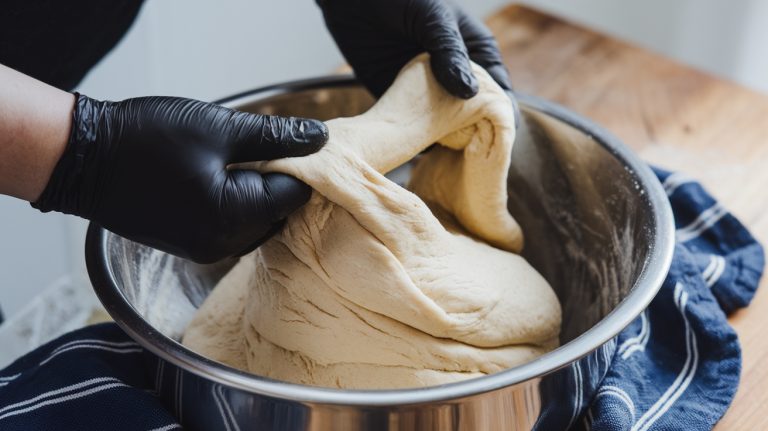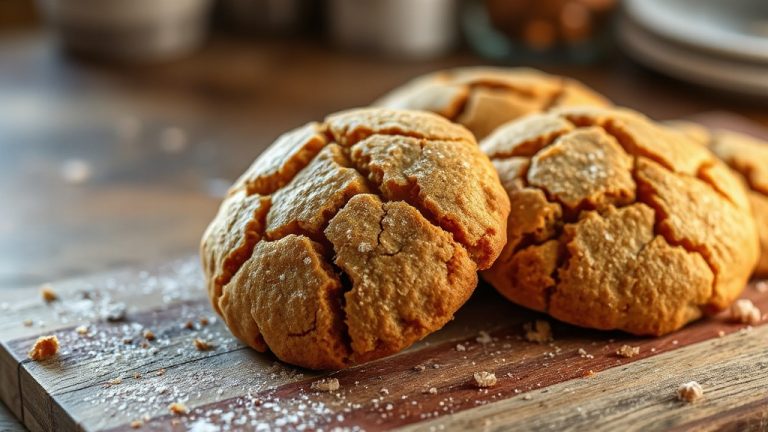Sourdough Apple Bread: That Stays Fresh Longer
To make sourdough apple bread, start with an active starter fed 4–10 hours prior to baking for strong leavening. Choose firm apples like Granny Smith, dice about ½ inch, cook with butter and cinnamon to reduce moisture and boost flavor.
Incorporate apples during stretch-and-folds, maintaining dough hydration above 70% for extensibility. Bake covered initially at 450ºF for steam, then reduce heat to set crust.
These steps ensure a tender crumb and balanced sweetness. Further guidance covers mixing, shaping, and spice balance.
Key Takeaways
- Use an active, well-fed sourdough starter to provide natural yeast and lactic acid bacteria for leavening and flavor development.
- Select firm apple varieties like Granny Smith or Honeycrisp, dice about ½ inch, cook with cinnamon and butter, then cool before adding.
- Incorporate cooked, drained diced apples during gentle stretch and fold phases to maintain dough extensibility and fruit texture.
- Bake in a preheated Dutch oven at 450ºF covered for 15–20 minutes, then reduce to 350–375ºF until internal temperature reaches 200–210ºF.
- Sourdough fermentation enhances nutrient bioavailability, while apples add natural sweetness, fiber, and antioxidants for a nutritious bread.
Sourdough Apple Bread Recipe at a Glance
| Step | Ingredient | Quantity | Key Notes | Purpose |
|---|---|---|---|---|
| 1 | Active sourdough starter | 100g | Fed 4–10 hrs prior | Leavening & flavor |
| 2 | Bread flour | 400g | Unbleached preferred | Structure & gluten |
| 3 | Water | 280g | Lukewarm | Hydration |
| 4 | Salt | 8g | Fine sea salt | Flavor balance |
| 5 | Apples (Granny Smith/Honeycrisp) | 200g diced | ½-inch pieces, cooked with cinnamon & butter | Sweetness & texture |
| 6 | Butter | 15g | Melted | Richness & moisture |
| 7 | Cinnamon | 1 tsp | Ground | Warm spice aroma |
| 8 | Brown sugar | 15g | Light or dark | Enhances apple caramelization |
| 9 | Nutmeg | ¼ tsp | Optional | Depth & aroma |
| 10 | Optional sweet apples (Pink Lady/Braeburn) | 50g diced | Mixed with tart apples | Balanced flavor |
| 11 | Olive or vegetable oil | 10g | Mixed into dough | Moisture retention |
| 12 | Extra flour | As needed | For dusting apples | Prevent sogginess |
Baking Instructions:
- Bulk Fermentation: Mix flour, water, and starter. Rest (autolyse) 30 mins. Add salt, sugar, and oil.
- Stretch & Fold: 3–4 times at 30-min intervals, incorporating cooled apples mid-way.
- Proof: Cover and proof until doubled.
- Bake: Preheat Dutch oven to 450ºF. Bake covered 15–20 min, then uncovered at 350–375ºF until internal temp reaches 200–210ºF.
- Cool: Fully before slicing for best crumb texture.
The Role of Sourdough Starter in Apple Bread
Although you might be tempted to rely on commercial yeast, using a sourdough starter in apple bread provides natural yeast and lactic acid bacteria that leaven the dough effectively while adding complex, mildly tangy flavors. Fed starters, in particular, ensure consistent dough activity and better rise, which is crucial for artisan-style breads.
Using sourdough starter in apple bread enhances rise and flavor with natural yeast and tangy complexity.
To guarantee optimal fermentation, feed your starter 4 to 10 hours before mixing. Active, bubbly starter guarantees proper rise and tender crumb.
The starter initiates slow fermentation, allowing enzymatic breakdown of flour proteins that enhance moisture and texture. Its organic acids balance the sweetness of apples and spices, preventing cloying taste and extending shelf life by inhibiting mold growth. Using oil such as olive or vegetable oil in the recipe helps keep the baked bread moist for days.
Incorporate the starter gently using slow mixing and warm hands to maintain dough consistency. Remember, starter hydration and flour type influence fermentation speed and flavor complexity, so adjust these variables based on your desired outcome and the feeding cycles of your starter.
Selecting the Best Apples for Flavor and Texture
When selecting apples for sourdough apple bread, prioritize firm varieties like Granny Smith and Honeycrisp to guarantee the fruit maintains its shape and texture during baking. Using quality ingredients such as these apples ensures better fermentation and flavor development in the bread.
Granny Smith apples contribute tartness that balances sweetness and limits moisture release, while Honeycrisp adds natural sweetness and crispness with thicker skin to preserve crumb integrity.
Avoid softer apples, as they break down, causing sogginess.
For enhanced flavor complexity, combine tart and sweet apples—Pink Lady or Braeburn work well.
Choose fresh, locally grown apples stored properly to ensure excellent firmness and flavor. This selection minimizes excessive moisture, reducing the need for extra flour or thickening agents, and helps retain bread structure.
Incorporating grated apples directly into the dough also adds moisture and sweetness essential for a flavorful loaf.
Ultimately, your apple choice directly influences texture stability and taste balance in your sourdough apple bread.
Preparing Apples for Optimal Moisture and Sweetness

To prepare apples for sourdough bread, start by choosing varieties with balanced sweetness and firmness to make certain proper texture. You’ll want to cook or caramelize apples briefly to concentrate sugars and reduce excess moisture, which helps maintain bread structure. Using Granny Smith apples is recommended because they are tart and ideal for baking.
Finally, manage moisture by grating or chopping apples uniformly and pressing out surplus liquid to prevent sogginess while preserving necessary hydration. Covering the dough with a waterproof barrier during proofing helps retain this moisture and keeps the bread fresh.
Selecting Apple Varieties
Because apple variety directly affects both moisture content and sweetness, selecting the right types is essential for achieving ideal texture and flavor in sourdough apple bread.
Choose sweet varieties like Honeycrisp, Pink Lady, Braeburn, or Fuji to enhance natural sugars and improve crust caramelization. Incorporate tart apples such as Granny Smith to balance sweetness and add acidity, complementing the sourdough tang.
Opt for firm apples, including Granny Smith and Honeycrisp, to maintain shape and prevent excess liquid release that causes sogginess. Consider blending varieties—combine Granny Smith with Pink Lady—to optimize moisture and flavor complexity.
Leave skins intact to preserve fiber, nutrients, and add textural contrast. These decisions directly influence moisture retention, crumb structure, and the final flavor profile, ensuring your sourdough apple bread is both tender and well-balanced.
Using multiple forms of apple such as applesauce, apple cider, and freshly grated apples enhances depth of flavor and moisture in the bread. Additionally, baking on surfaces with high thermal conductivity can further improve crust development by promoting rapid heat transfer during baking.
Cooking and Caramelizing Apples
Although caramelizing apples requires careful heat control, mastering this process guarantees ideal moisture retention and flavor concentration. Start by peeling, coring, and cutting apples into uniform 1/4-inch pieces for even cooking.
It is important to prepare other ingredients before chopping the apples to minimize oxidation and browning. Adjusting cooking times and temperatures based on environmental factors can further ensure consistent results.
Heat butter over medium to medium-high heat until melted, then add apples coated with lemon juice to prevent oxidation. Cook for 5 to 7 minutes, stirring frequently to soften and brown the apples evenly.
Next, add brown sugar and cinnamon, reduce heat, and continue cooking 5 to 15 minutes until syrup thickens and apples develop a glossy, deep golden color. Stir at least once per minute to avoid burning and promote uniform caramelization.
Remove from heat once the mixture forms a thick, sticky glaze with intensified aroma, signaling optimal moisture and sweetness for your sourdough apple bread. Maintaining the right moisture balance is crucial to prevent a soggy dough and ensure a well-structured loaf.
Balancing Moisture Content
When preparing apples for sourdough bread, you must carefully balance their moisture contribution to maintain ideal dough hydration and texture. Fresh apples contain 80-85% water, markedly affecting dough hydration at typical 30% baker’s percentage inclusion.
The original dough hydration is very low, resulting in a stiff dough that required an extra 10% water during mixing. Using a bread mix like Krusteaz Sourdough Bread Mix, which is adaptable for different hydration levels, can help accommodate these adjustments more easily due to its no-knead formulation and flexible baking options.
Choose preparation methods wisely: grated apples release moisture rapidly, wetting the dough early, while diced or peeled apples slow moisture release. Adjust added water accordingly—firmer, drier apple varieties or dried apples require compensatory hydration; conversely, juicy varieties demand less water.
Toss apple pieces lightly in flour before folding them in to bind surface moisture and prevent sogginess. Monitor dough consistency during mixing rather than relying solely on hydration percentages, since apple fiber absorbs water and stiffens dough. This approach aligns well with using a mix that supports customization options allowing for ingredient additions without compromising dough performance.
These precise adjustments ensure balanced moisture, ideal crumb texture, and sweetness without compromising dough handling.
Balancing Spices to Enhance Apple Flavor
To highlight the natural tartness and sweetness of apples in sourdough apple bread, you need to balance spices carefully, selecting both types and quantities that enhance rather than overpower the fruit. Start with about 1 teaspoon of cinnamon per loaf as a base, providing warm, sweet notes that complement apples. Consider the hydration levels in your dough since moisture from the apple filling can affect texture.
Add ¼ teaspoon nutmeg for aromatic depth, but avoid excess to prevent bitterness. Use ginger and clove sparingly—pinches or less than ¼ teaspoon—to introduce subtle zest and complexity without overwhelming the apple flavor.
Fold spices into the apple filling to maximize direct contact and flavor synergy. When preparing the filling, it is important to cook diced apples with cinnamon and butter until softened and cooled to prevent sogginess. Adjust sugar levels between 1 to 2 tablespoons to offset spice intensity and maintain balance.
Consider pre-mixed blends like pumpkin pie spice for convenience and consistent warmth.
Mixing and Baking Techniques for Tender Crumb
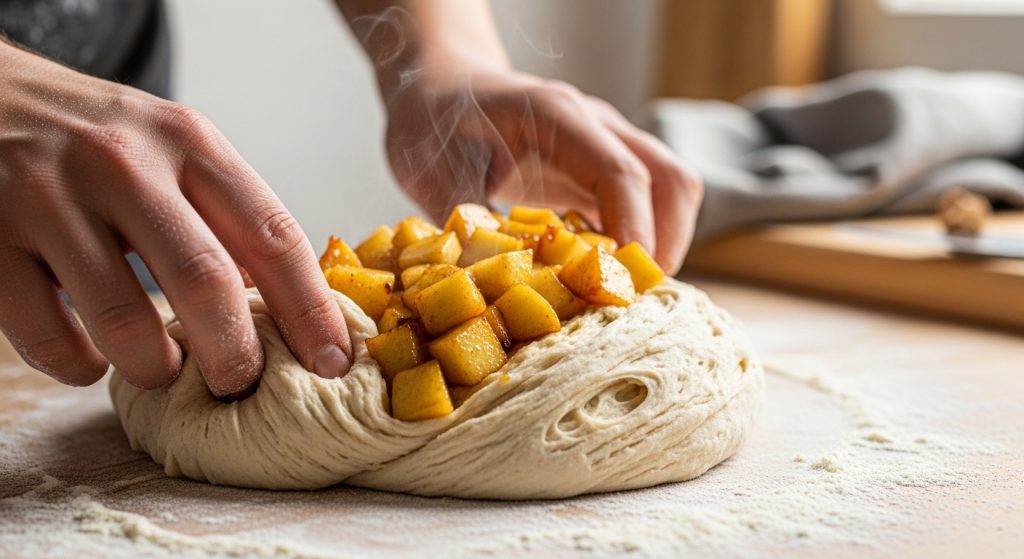
You’ll want to mix the dough gently to prevent overdeveloping gluten, stopping as soon as the ingredients are just combined for a tender crumb. This careful mixing helps maintain the dough’s hydration balance, which is key when working with sticky apple dough.
Start baking at a high temperature to maximize oven spring, then reduce heat to make sure even cooking without drying out the bread. These precise techniques balance structure and moisture, resulting in a soft, airy sourdough apple loaf. For best results, consider freezing slices after baking to preserve the loaf’s freshness and enhance its resistant starch content.
Gentle Mixing Methods
Although sourdough apple bread doughs tend to be wetter and more delicate, employing gentle mixing methods like the stretch and fold technique helps you develop gluten gradually without overworking the dough. Perform 2–4 sets of stretch and folds at 30-minute intervals during bulk fermentation, stretching the dough from all sides to build structure.
Gradually incorporate uniformly diced apple pieces (about ½ inch) during these folds, using a slotted spoon to drain excess liquid from cooked apples to reduce stickiness. This method traps fruit within dough pockets, preserving their integrity and preventing crushing.
Avoid aggressive kneading, which tightens gluten and toughens crumb. Implement autolyse and rest periods to hydrate flour and relax gluten, enhancing extensibility. Maintaining moisture and temperature during rests supports fermentation, ensuring a tender, open crumb structure in your sourdough apple bread.
Using gentle mixing speeds can also help maintain dough integrity and prevent damage during mixing. For best results, avoid overmixing the batter to prevent a dense texture, mixing only until just incorporated to maintain moist crumb.
Optimal Baking Conditions
When baking sourdough apple bread, controlling temperature and moisture during the initial and final stages is essential to achieving a tender crumb and well-developed crust. Start by preheating your Dutch oven to 450ºF.
Resting the dough for approximately 30 minutes before shaping allows the flour to hydrate fully, which contributes to a better texture in the final loaf autolyse phase. Using an ergonomic handle bread knife can help achieve perfect slices once baking is complete.
Cover the dough to trap steam for 15-20 minutes, promoting oven spring and starch gelatinization. Then, uncover and reduce the heat to 350-375ºF for 10-40 minutes to brown the crust and set the crumb. Target an internal temperature of 200-210ºF for doneness.
Follow these key steps:
- Maintain dough hydration above 70% to balance extensibility with moisture.
- Distribute apple pieces evenly to avoid dense clusters.
- Use parchment paper for easy dough transfer.
- Cool bread completely on a wire rack to stabilize crumb texture.
Tips for Achieving Perfect Rise and Crust

Ensuring your sourdough starter is active and well-fed plays a crucial role in achieving a perfect rise and crust for sourdough apple bread. Feed your starter 4-10 hours before mixing to reach peak activity, confirmed by abundant bubbles.
During dough preparation, allow a 30-minute autolyse for ideal hydration. Then add salt and sugar before kneading until smooth and elastic. It is important to knead the dough sufficiently to achieve a smooth, soft texture that is slightly tacky but not sticky.
Perform stretch and folds every 30 minutes during bulk fermentation, maintaining moisture by covering the dough in a lightly oiled bowl.
Bake initially at 425ºF (218ºC) for 10 minutes to encourage oven spring and crust formation. Then reduce to 350ºF (177ºC) for 50-55 minutes. Using a 9×5-inch loaf pan helps the bread maintain its shape during baking.
Use a Dutch oven to trap steam, promoting crust texture and expansion.
Let the bread cool fully before slicing to preserve crumb structure and crust integrity.
Nutritional Benefits of Sourdough Apple Bread
Mastering the rise and crust of sourdough apple bread enhances not only its texture but also preserves its nutritional profile. You benefit from a nutrient-dense loaf rich in fiber, protein, and essential minerals.
Sourdough fermentation improves digestibility and mineral bioavailability by degrading phytic acid, enhancing iron and zinc absorption. The inclusion of apples adds natural sugars, antioxidants, and additional fiber, complementing the bread’s health attributes. Additionally, sourdough’s bacteria and prebiotics act as food for beneficial gut bacteria, aiding digestion and nutrient absorption.
Key nutritional benefits include:
- Sustained energy release from 7g fiber and a balanced macronutrient profile per serving.
- Prebiotic fibers from fermentation that support gut microbiome and improve digestion.
- Lower glycemic response, benefiting blood sugar control and insulin sensitivity.
- Enhanced antioxidant intake from apples and cinnamon, reducing oxidative stress.
Use whole-grain flours to maximize fiber and micronutrient content.
Frequently Asked Questions
Can I Freeze Sourdough Apple Bread for Later Use?
Yes, you can freeze sourdough apple bread for later use. Make sure to cool it completely, then wrap it tightly in plastic wrap or foil to prevent freezer burn.
Place the wrapped bread in an airtight container or freezer bag for added protection. Freeze it for up to 2-3 months.
When ready, thaw it in the refrigerator or at room temperature, then reheat gently to restore softness and flavor before serving.
How Long Does Sourdough Apple Bread Stay Fresh at Room Temperature?
You can keep sourdough apple bread fresh at room temperature for up to 2 days due to its high moisture content. Store it in an airtight container or bread bag to maintain crust texture and prevent drying.
Avoid exposing it to heat or sunlight, which accelerates spoilage. Beyond 2 days, mold risk increases, so refrigerate or freeze to extend shelf life.
Proper wrapping and cool conditions help preserve freshness within this timeframe.
What Is the Best Way to Reheat Sourdough Apple Bread?
You should preheat your oven to 350°F for even warming. Lightly spritz the bread with water to maintain moisture, then wrap it in foil to prevent drying.
Heat whole or sliced bread for 10–15 minutes, checking slices after 6–8 minutes. Remove foil and place bread briefly on a cooling rack to restore crust texture.
This method balances moisture retention with a crisp crust, ensuring peak reheating results.
Can I Substitute Sourdough Starter With Commercial Yeast?
Can you replicate sourdough starter’s complex fermentation with commercial yeast? Technically, yes—you can substitute commercial yeast to leaven dough faster and more predictably. However, you’ll sacrifice flavor complexity, tanginess, and some nutritional benefits inherent to wild yeast fermentation.
Adjust rising times and hydration because commercial yeast ferments quickly. Remember, your bread’s texture and taste will differ; commercial yeast lacks the organic acids and bacteria that create sourdough’s characteristic profile.
How Do I Store Leftover Sourdough Apple Bread to Retain Moisture?
To retain moisture in your leftover bread, store it at room temperature up to 24-48 hours in an airtight container or resealable plastic bag. Avoid refrigeration, as it dries bread faster.
For longer storage, freeze slices wrapped tightly in plastic wrap and placed in freezer bags. Always cool bread completely before packaging to prevent condensation.
Defrost at room temperature or refrigerate overnight, and reheat gently to restore texture without drying out.
Make Every Loaf a Flavorful Masterpiece
By mastering your sourdough starter and selecting crisp, flavorful apples, you’ll craft apple bread that rises like a well-tuned symphony.
Remember to prep apples for balanced moisture and sweetness, then measure spices precisely to highlight their natural taste.
Follow mixing and baking techniques carefully to achieve a tender crumb and perfect crust.
With these steps, your sourdough apple bread won’t just nourish—it’ll elevate your baking to an art form.

